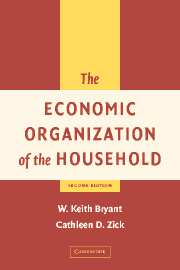Book contents
- Frontmatter
- Contents
- List of Figures
- Preface to the Second Edition
- 1 Introduction
- 2 Household Equilibrium
- 3 The Analysis of Consumer Demand
- 4 Consumption and Saving
- 5 Work and Leisure : How the Household Spends Its Time
- 6 Human Capital : Investing in Oneself and One's Family
- 7 The Economics of Fertility
- 8 The Economics of Marriage and Divorce
- References
- Index
6 - Human Capital : Investing in Oneself and One's Family
Published online by Cambridge University Press: 06 July 2010
- Frontmatter
- Contents
- List of Figures
- Preface to the Second Edition
- 1 Introduction
- 2 Household Equilibrium
- 3 The Analysis of Consumer Demand
- 4 Consumption and Saving
- 5 Work and Leisure : How the Household Spends Its Time
- 6 Human Capital : Investing in Oneself and One's Family
- 7 The Economics of Fertility
- 8 The Economics of Marriage and Divorce
- References
- Index
Summary
Fully 25 percent of the U.S. population, 72.7 million people, were enrolled in school in 1999. Of those in school, 6.3 percent were in nursery school, 52.7 percent were enrolled in kindergarten or elementary schools, 20.5 percent were enrolled in high schools, and 20.5 percent were enrolled in institutions of higher education (U.S. Bureau of the Census 2000b, Table 239, p. 151, and Table 259, p. 162). These numbers exclude the millions of people who took private lessons in everything from sewing to music, from religion to skiing and hang gliding. The United States devoted 6.7 percent of its gross national product, $601 billion, to schools and schooling in 1999. Of this sum, $372 billion was spent on elementary and secondary schools, and $239 billion was spent on colleges and universities (U.S. Bureau of the Census 2000b, Table 240, p. 151). These figures ignore the billions of dollars of potential income students chose not to earn by virtue of their being in schools and colleges.
Turning to the nation's investment in and maintenance of their health stock, Americans spent $1113.7 billion on health services and medical facility construction in 1998 and $19.3 billion on medical research in 1998, an amount totaling 13.5 percent of GDP (U.S. Bureau of the Census 2000b, Table 151, p. 108). This excludes all of the expenditures on recreation equipment and lessons that build and maintain healthy bodies. Also excluded is the value of the time Americans spent in maintaining their health.
- Type
- Chapter
- Information
- The Economic Organization of the Household , pp. 198 - 235Publisher: Cambridge University PressPrint publication year: 2005



